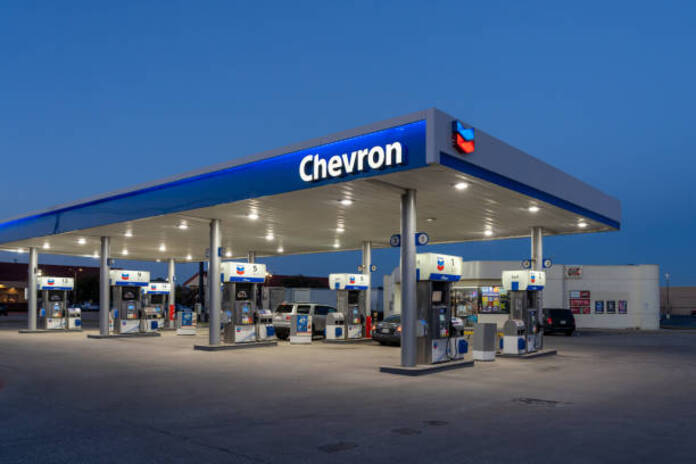Chevron Corporation (NYSE:CVX) recently released its second-quarter earnings report, which exceeded market expectations with adjusted earnings per share of $3.08. The figure surpassed the consensus estimate of $2.95, showcasing the company’s solid performance during the period. The impressive results were largely attributed to the strong showing in Chevron’s key upstream segment, where profit reached $4.9 billion. This outcome surpassed earlier projections of $2.9 billion, and the success can be primarily attributed to the company’s record-breaking domestic production levels. Chevron stock has fallen by 9% year-to-date.
However, despite the positive aspects of the report, Chevron’s earnings declined when compared to the year-ago adjusted profit of $5.82. The decrease can be attributed to weaker realizations in oil and natural gas prices, as well as a dip in refined product sales margins. These challenges in the energy market impacted the company’s overall earnings for the second quarter.
In terms of revenues, Chevron generated $48.9 billion during the quarter. While this is a substantial figure, it missed the consensus estimate of $51.4 billion and represented a 28.9% decrease compared to the same period last year. The decline in revenues is indicative of the broader market challenges faced by the energy sector, particularly with fluctuating commodity prices and economic uncertainties.
Analyzing Chevron’s segment performance, the upstream division demonstrated notable growth, with crude oil and natural gas production reaching 2,959 thousand barrels of oil equivalent per day (MBOE/d) and with 59% liquids. This reflected a 2.2% increase compared to the previous year, and the success was largely attributed to the company’s impressive operations in the Permian basin. The Permian basin is renowned as America’s most prominent and cost-effective shale region, driving Chevron’s strong output during the period.
Of particular note, Chevron achieved a record U.S. output of 1,219 MBOE/d, representing a remarkable 4% increase year over year. Furthermore, the company’s international operations, accounting for 59% of the total, also showed modest growth, rising by 0.9% to reach 1,740 MBOE/d. Despite these positive production figures, the upstream segment’s profit experienced a significant decline of 42.3% to $4.9 billion in the second quarter of 2023. This decrease can be largely attributed to the sharp drop in oil and natural gas prices during the period.
The average realized liquid prices in the U.S. were $56 per barrel, which is $33 lower than the previous year. Overseas prices slumped by 33.3% to $68 per barrel. As for natural gas, the prices were impacted more severely, declining by 80.2% in the U.S. and by 18.7% internationally. These market fluctuations had a direct impact on Chevron’s earnings and profitability within the upstream segment.
Moving on to the downstream segment, Chevron reported a profit of $1.5 billion, reflecting a decrease from the previous year’s figure of $3.5 billion. This dip in profitability was mainly driven by lower product sales margins, higher operating expenses in the U.S., and adverse foreign currency effects. The downstream segment faced its own set of challenges in the market, which affected its overall financial performance during the second quarter.
In terms of cash flows and capital expenditure, Chevron generated $6.3 billion in cash flow from operations during the quarter. While this figure is substantial, it represents a decrease compared to the $13.8 billion recorded during the same period last year. The decline in cash flow can be attributed to weaker price realizations in the upstream business, reflecting the broader challenges in the energy market.
Chevron’s free cash flow for the quarter amounted to $2.5 billion. Additionally, the company spent $2.8 billion on dividends and repurchased $4.4 billion worth of its shares. These financial decisions demonstrate Chevron’s commitment to returning value to its shareholders, even amid challenging market conditions.
Overall, despite facing challenges in the market, Chevron managed to deliver strong results in its key upstream segment, driven by robust U.S. production levels. The company’s performance reflects its continued commitment to managing operational efficiency and cost optimization.
Looking ahead, Chevron’s management expects fiscal year 2024 sales growth in the range of 3% to 4% compared to the previous year. The company also anticipates organic sales growth, excluding deals and currency movements, to be in the range of 4% to 5%. In terms of net earnings per share growth, Chevron projects a range of 6% to 9% for the current year, equivalent to a range of $6.25 to $6.43 per share, with a mid-point estimate of $6.34. This reflects an increase of 7.5%. While it fell slightly below analysts’ expectations of $6.37 per share, the company’s continued focus on growth and financial discipline has earned the confidence of investors, as evidenced by a 3% rise in Chevron stock in morning trading on Friday.
In conclusion, Chevron’s second-quarter results reflect the resilience and adaptability of the company in navigating the challenges posed by fluctuating commodity prices and market uncertainties. While there are obstacles to overcome, Chevron’s strong performance in its key upstream segment and its commitment to cost optimization and shareholder returns position it favorably for future growth and success in the ever-evolving energy industry.
Featured Image:















